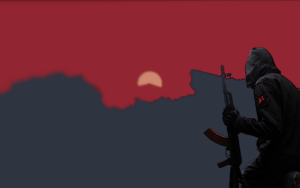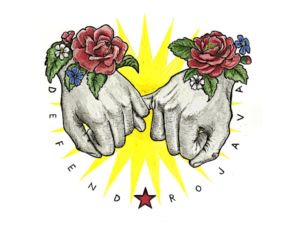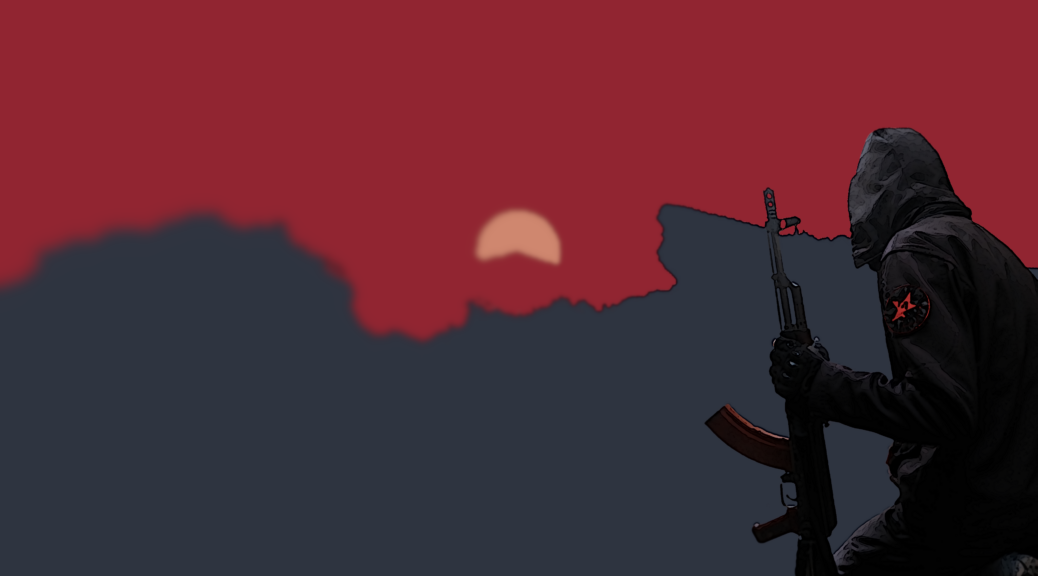This interview was originaly published in asranarshism.com
With greetings to the comrades in Tekoşîna Anarşîst;
We, as individual and collective self-organizations within the Federation of Anarchism Era in the geography of Afghanistan and Iran, are pleased to send you this interview in the form of questions and answers. The hope is that publishing this interview will provide our audience with a better understanding of your ideas and an insight into a decade of your anarchist struggles in Rojava, Kurdistan.
- Please share with us the history behind the organization of Tekoşîna Anarşîst and the types of activities you engage in.
Tekoşîna Anarşîst is an anarchist organization that has been fighting in Rojava since 2017, when it was formed. We came together to give collective answers to the questions and hopes that brought many of us here, to support and to defend this revolution. This forced us to reflect about our dynamics and our history, not just as individuals or as organization, but also as a movement. Coming together from different places and different anarchist traditions created some challenges for us, but it also opened opportunities to develop more diverse and comprehensive analysis and perspectives. This allowed us to reflect on strengths and shortcomings of the movements we come from, as well as ways to improve.
Here we struggle together with the Kurdish Liberation Movement, and this has been one of the main sources of inspiration for us. We also work with other revolutionary organizations that came to defend this revolution, as well as local structures of this revolutionary society. Many Syrian Arab comrades from different parts of Syria are now working with the self-administration, as well as local Armenians, Assyrians, Turkmens and many more, organizing their communities and building this colorful confederal system. All this creates a unique and extraordinary ground from where we can gather experience and learn important lessons, that we also work to translate and share with other anarchist groups and organizations.
Many things changed in the more than 7 years we have been here, and we also had to adapt our work to the circumstances. The first years of our organization where mostly focused on the war against ISIS, with our participation in the front lines to defend the revolution being our priority. We also had to confront the Turkish bombs in the invasions of Afrin and Serekaniye, as well as the constant attacks of Turkish army and their proxy forces. As time passes, we are growing more rooted and integrated in the local reality, allowing us to have better insights of what it means to make a revolution. This brings important reflections on how to build revolutionary movements back home, evaluating what our movements are doing right and where we should direct our efforts. In the last years we have been working on some documents and materials that resulted from our studies on different anarchist revolutions and movements, aiming to open a wider debate about the situation of the anarchist movement today. We hope that we can continue working on that soon, but for now we had to halt all our activities due to the ongoing events in Syria. Probably you know about it, but finally the regime collapsed and al-Assad is gone. We wrote a couple of statements about that and we are writing updates about the situation on the ground.
- Were you aware from the outset of the manifesto and the action plan implemented in North and East Syria? How did you come into contact with this knowledge?
The ideas of Abdullah Öcalan and the ‘Manifesto for a Democratic Civilization’ were known to some of us before coming here. Many of those ideas have many similarities with Bookchin’s proposal of libertarian municipalism, connected to what he framed as social ecology. The book “Ecology of Freedom” has a very clear influence in the philosophy of Öcalan, and they even exchanged some letters before Bookchin passed away. But it was with the resistance of Kobane against ISIS that the struggle of the Kurdish people gained international attention.
After that, many more internationalists started to come here. The International Freedom Battallion was formed in answer to that new mobilization, taking inspiration from the international brigades in the Spanish revolution of 1936. Many anarchists fought in the ranks of IFB, together with many other groups and organizations, building international bridges and networks of solidarity. The word spread fast among anarchist circles, and soon we were also organizing solidarity committees with the Rojava Revolution all around the world.
Many anarchists followed the steps of those who traveled here, and many more joined the solidarity committees and initiatives to support the revolution from abroad. The books of Öcalan also started to be published in other languages, making them more accessible to non Kurdish and Turkish speakers. Articles and statements were written for anarchist websites and magazines, talks and debates about Rojava became common at anarchist bookfairs, many anarcho-syndicalist unions and even punk music groups made campaigns to support Rojava. Those on the ground were reporting to comrades back home, igniting a new lighthouse for international revolutionaries, often connected with past traditions like Chiapas and Palestinian solidarity. Among those lines you can find most of our trajectories, but of course every one of us have quite extraordinary stories about how we ended up here.
- To what extent do you assess that the “Manifesto of Democratic Confederalism” aligns with and is closely connected to the anarchist alternative? Is this solely a nationalist revolution or also an anti-capitalist and class revolution?
We discussed those question in depth for years, and soon we expect to publish more organized materials about that. But in short, yes, it aligns with anarchist and anti-capitalist values, that’s why we are here. It is a revolution born from a national liberation struggle, but it also transcends the logic of nation-state with arguments that anarchists upheld for more than a century. This brings important lessons and anti-colonial perspectives, that especially western anarchists should consider and reflect on. The model of democratic confedralism proposed by Öcalan is tailored to the reality of the kurdish struggle, but it can be an inspiration and a blueprint for many other liberation movements. It’s implementation in Rojava is still in progress, but already many impressive steps have been made. 12 years is not time enough to achieve the anti-patriarchal, anti-capitalist and anti-state model proposed; revolution is a process and not an event. The speed and extent of these transformations are conditioned by the situation of war and the material reality , and also depend on the relations, alliances and balance of forces with other actors on the ground.
The question of class, fundamental for anarchist theory and it’s development, has a different meaning for a colonized people in the Middle East than for the European working class of the 19th century. Furthermore, the issue of how we approach the question of class in the 21st century is a widely contested point and topic of discussion between different anarchist tendencies. For those interested in this discussions, we expect to publish soon some materials and evaluations that can help to clarify our perspective on it. As we said before, this theoretical work is something that the current attacks on Syria forced us to put on hold, but if the situation stabilizes we will give priority to that work. We hope the discussions that follow can bring new arguments and perspectives, building better coherence among anarchist revolutionary tendencies.
- Have any regional governments or international alliances taken measures to support and defend the regions in North and East Syria?
For now the government of Catalonia is the most relevant institution that officially recognized the Democratic Autonomous Administration of North and East Syria (DAANES). There have been some partnerships at the municipal level with different Italian and German cities, as well as political delegations from Scotland, France, Basque country and many other places. But most of these institutional partnerships stay on a surface level of humanitarian and international cooperation and support. There has also been correspondence with revolutionary forces in Myanmar, as well as solidarity calls from Chiapas and other autonomous territories, but nothing that had a massive impact on the ground. The most relevant example we can mention is probably the new hospital built in Qamishlo, funded by the municipality of Barcelona together with other organizations and institutions for international cooperation.

- Considering that the fascist Turkish government’s airstrikes against the northern and eastern regions have been ongoing for several years and that the government’s mercenaries now control more areas in Syria, what is your view on the future of democratic confederalism in North and East Syria?
The revolutionary project will continue, fighting to defend the social transformations achieved until now. Self-defense is a primary element of this revolution, and people will fight fiercely to defend the revolution, not just on the front lines but also on the political and social spheres. The revolution of Rojava always claimed itself as part of Syria, not pushing for a formal independence but for a democratization of Syria in a federal system. Diplomatic bodies of the DAANES are already in talks with the provisional government working in that direction. They published a list of 10 points for to the ongoing negotiations, calling for unity and sovereignty of Syria, a stop to military aggressions and occupations, the right to return for displaced people, fair distribution of wealth and more women’s participation in politics. As for now, there are diplomatic efforts to be part of the transitional process ongoing in Syria. The military defense against Turkish occupation is still the main priority, and those two spheres are interconnected. We know that too often power stems from the barrel of a gun, but it is when combined with political organization that social transformations are possible.
There is also a need of more military activity against the resurgence of ISIS, that has dramatically increased their attacks since the collapse of the regime. The caliphate was defeated but some cells still active in the Syrian desert, now more than? they raided and looted some army depots from the old regime when soldiers ran away. The Islamist groups supported by Turkey are also giving ISIS new motivation to attack, making use of the instability of Syria and the mobilization of SDF to the front lines to expand their activities. Intelligence agencies are already calling attention to the threats this poses. Thousand of ISIS fighters are currently held in SDF-controlled territories, and Turkey has bombed security facilities next to ISIS prisons in the past, facilitating mutinies and escape attempts, some of which even succeeded. This would be catastrophic, not just for Syria and the Middle East but for the whole world.
Even if we manage to avoid these catastrophic scenarios, the future of the revolution will see big challenges. With the current transitional government in such close relations with Turkey, any negotiations are going to be very hard, with conditions put on the table that are going to be in many ways humiliating. Turkey have a massive army ready to invade Syria, this means that the self-administration is navigating a path where wrong steps can easily lead to annihilation. This is therefore a crossroad between existence and annihilation, a struggle for the right to exist in the new Syria in the making.
The DAANES will have to make important concessions to be allowed to continue, while pushing for a federal model that allows a certain degree of autonomy. Many minorities and secular groups will easily find themselves in harmony with the political proposal of the DAANES, but the authoritarian lines of HTS will be invigorated by any external support. This means that the more Turkey steps in and makes deals with HTS, the more the international community legitimizes the transitional government of HTS, the more difficult for the revolution to reach good agreements on the diplomatic table. On the other hand, the more that other minorities, other revolutionary and secular groups and specially womens organizations fight back in harmony with the political project of the DAANES, the more strength we will have in the negotiations for a democratic and decentralized Syria.
But of course the most important is that people continue organizing in their local communes and regional councils, making sure that whatever form of State comes after, popular power grows stronger and more able to resist any State interference. We, as international revolutionaries, have a responsibility to support this process and defend the achievements of this revolution. But also, as anarchists, should keep always a critical voice on those statecraft politics that remove agency from the people, imitating parliamentary politics and moving away from grassroots organizing. After years here, we also need to come to terms with the material conditions of the reality on the ground, aware that a Turkish military occupation will be catastrophic for the important steps achieved until now. Ideological dogmatism may look nice when we read it in theory books, but Rojava made it so far partly thanks to the pragmatic flexibility of the kurdish liberation movement. We have our ideological line, but also a lot of important lessons we can learn from what is going on here.
- On January 20, 2018, the canton of Afrin was occupied and taken over by the fascist Turkish government forces following a military offensive. Does the “Syrian Democratic Forces” have any plans to reclaim and liberate this canton?
SDF always stated their intention to return to Afrin, and of course with the ongoing situation this is now more relevant than ever. Many refugees from Afrin were living in refugee camps in the region of Shehba, area that the Turkish proxies occupied in this last offensive. More than 100.000 people have been forced to flee once again from the Turkish bombs and their jihadist mercenaries, unraveling a new humanitarian crisis. These are people from Afrin that are waiting for SDF to liberate those territories to go back to their homes. We also need to remark that the Afrin Liberation Forces have been carrying out insurgent actions against the occupation for more than 6 years, attacking Turkish military bases and taking down commanders of the occupation forces. With the recent developments, one of the conditions brought by diplomatic bodies of the self-administration in negotiations with the provisional government of HTS is the return of all IDP to their homes. Of course, this includes Afrin. We know that Turkey will not withdraw their occupation out of good will, and that probably this will be something that will require use of force. SDF is now pushing on many fronts, playing 4D chess to ensure the survival of the revolutionary developments of north-east Syria. If the conditions for the liberation of Afrin ripen, be sure that SDF will push for any chance to make it happen.
- How can Libertarian individuals and Anarchist unions around the world join the revolutionary process in the region or show their solidarity with this revolution?
There are many things you can do, we already gave some examples in our last statement “We carry a new world in our hearts”. But besides all these important (and practical) ways to support the revolution, there is another element we want to call your attention to.
As anarchist, we know that we are not free until everybody is free, therefore any revolutionary process in Syria won’t be able to survive if it is not in harmony with many other revolutionary processes all around the world. We won’t change the world tomorrow, not in the next years, and probably not even in our lifetimes. A truly revolutionary process to abolish patriarchy, overthrow capitalism and wither the states away will need a long time. It will also need a world wide revolutionary movement ready to fight for it. It is our duty to build such a movement, and for that we need to listen to each other, understand each other, and build alliances toward our revolutionary dreams. We also need to learn from past experiences and remember those who struggled and even gave their lives in the struggle, because if we are where we are today, it is thanks to their efforts and sacrifices. In that sense, we also call to remember Omar Aziz, an anarchist from Damascus that dedicated his life to the struggle, giving his life after suffering the hardships and tortures of the regime prisons. We honor his legacy together with many other anarchist comrades who gave their life here, like şehîd Ciwan Firan, şehîd Demhat Goldman, şehîd Kawa Amed, şehîd Şahîn Husseinî, şehîd Şevger Ara Makhno, şehîd Hêlîn Qereçox, şehîd Şahîn Qereçox, şehîd Tekoşer Piling, şehîd Elefteria Hambî. Those are just some of the anarchist revolutionaries who joined the ranks of this revolution and never went back home. Their memory is still alive in our hearts, we remember them together with all those who gave their life for this revolution. Revolutionary greetings!
Thank you for your participation in this interview with the Federation of Anarchism Era.
ONE WORLD, ONE STRUGGLE!
For Freedom! For life!

آدرس و اسامی صفحات مرتبط با فدراسیون عصر آنارشیسم
Federation of Anarchism Era Social Media Pages

